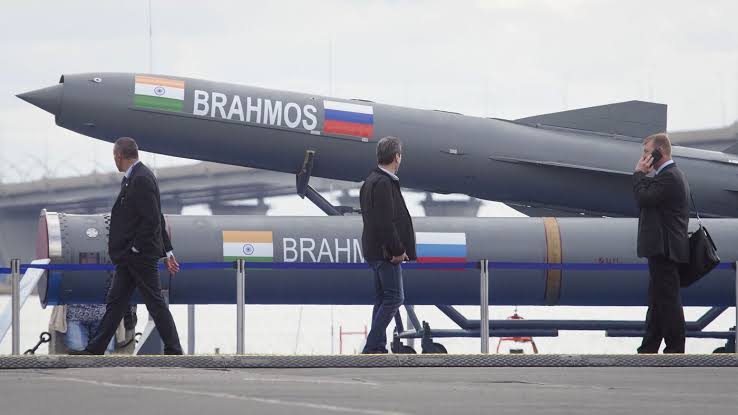Indian Navy’s new BRAHMOS NG will cover 800km+

Under its 15-year plan the Navy was determined to have indigenous weapons, including the BrahMos missile. In 1998, when the joint venture for BRAHMOS began, the indigenous capacity of the project was only 13%, said Atul Dinkar Rane, CEO and Managing Director, BrahMos Aerospace.
As of 2023, 75% indigenous capacity has been achieved, including manufacturing parts of the missile, spares, and checkout equipment used for testing it. More than 200 Indian industries were involved in the indigenisation and that the missile project itself had created 25,000 jobs.
In 2019, DRDO had test-fired the land version of extended range BrahMos with Indian fuel propulsion system, power supply and other features. An indigenous seeker and a booster were developed soon.
The next generation missile BrahMos-NG have an indigenous ramjet engine or propulsion system. Now India is in position to have 100% indigenisation of the BrahMos missile.
However being a joint venture between India and Russia, certain components designed by Russia will continue to be imported to maintain partnership for future developments.
Recently the Cabinet Committee on Security (CCS) on February 22 cleared the ₹19,000-crore acquisition of 200 BrahMos Extended Range (ER) supersonic cruise missiles for warships.
The formal signing of the contract between the Ministry of Defence (MoD) and the Indo-Russian company BrahMos Aerospace is expected to be held on March 5, government sources said.
Navy chief Admiral R Hari Kumar said that the BrahMos will be the Navy’s primary surface-to-surface missile as it has “enhanced range, capabilities, range and so on.”
“That is why we are replacing all old missiles with this… and we are installing the BrahMos. Now, we have the expertise to install it in a very quick time,” said Admiral Kumar, adding that as it was a ‘Made in India’ missile, there was no dependency on foreign companies to assemble, repair and maintain the missiles. His comments were made on the sidelines of the Defence Expo held in Pune on February 26.
In March, 2023 the MoD had signed a ₹1,700-crore deal with BrahMos Aerospace for procuring long range missiles and maritime mobile coastal batteries for the Indian Navy.
The Indian Navy’s warships or destroyers of the Vishakhapatnam class (INS Vishakhapatnam, INS Mormugao, INS Imphal), Kolkata class (INS Kolkata, INS Kochi, INS Chennai), Delhi class (INS Delhi, INS Mysore, INS Mumbai), Rajput class (INS Ranvir, INS Ranvijay) and frigates of the Shivalik class (INS Shivalik, INS Satpura, INS Sahyadri) and Talwar class (INS Teg, INS Tarkash and INS Trikand) are already equipped with BrahMos missiles.
The latest in production BrahMos Extended Range supersonic cruise missile (BrahMos-ER) have a range up to 400 km. The new version is capable of striking targets at a distance 800-900 km away from the ship it is mounted on. The Navy has not, however, specified a precise strike range. The NG missiles will go into production after a few more User trials.
The BrahMos-ER missile is a two-stage missile with a solid propellent booster as its first stage and a liquid-fuel fired ramjet engine as its second stage, which powers the missile beyond supersonic speed.
As per the last test-firing of the missile by the Indian Navy it clocked a speed of 2.8 Mach (almost three times the speed of sound). Operating on the ‘fire and forget’ principle — the missile can hit the target without external intervention after its launch — the BrahMos-ER is designed for long flight with a variety of trajectories and is said to hit its target with pinpoint accuracy and power with large kinetic energy on impact.
Carrying a conventional warhead of 200-300 kgs, the BrahMos-ER, like its predecessor, has a cruising altitude of up to 15 km, and can also go as low as 10 metres. As it has a low radar signature and travels at supersonic speeds, it reportedly cannot be intercepted by any known weapons system till date.
The missile can be launched from sea, land or air, and the base version missile has been a part of the Indian Navy’s arsenal since 2005, the Army’s since 2007 and the Air Force’s since 2020.
The Navy has the BrahMos missile in both inclined and vertical launch configurations in its ship-based weapon complex while the Army has the missile’s vertical launch configuration for mobile autonomous launchers.
The Air Force, which has newly inducted these missiles, has integrated them on its Su-30MKI fighter aircraft.
As per reports, extended range surface-launched versions of the missile costs just around INR 25 Crores, while the ship-based extended range missile costs approximately INR 60 Crores.
The first successful test of the BrahMos supersonic cruise missile, capable of travelling 290km, took place on May 22, 2013, when it was test-fired from from the Navy’s guided missile frigate INS Tarkash off the Goa coast.
The new extended range version, designed after 2016, was first tested in 2017 by the Indian Navy. It was fired from stealth frigate INS Teg in the Bay of Bengal on March 11, 2017.
The missile’s air-launched version was successfully test fired by the Indian Air Force from a Sukhoi Su-30MKI fighter aircraft against a ship target in the Bay of Bengal on December 29, 2022.
Finally, the missile’s land-based version was test-fired from the Andaman and Nicobar Islands by the Indian Army on October 10, 2023.
The latest test of the missile by the Indian Navy was on January 24, 2024. The Navy successfully test-fired a ship-launched version of the missile with an ‘enhanced range.’
Issuing a statement of the test on X, the Indian Navy posted that a ‘successful engagement of a land target with an advanced supersonic cruise missile’ had been carried out, enhancing India’s precision strike capability from combat & mission ready ships.
Prior to the test, the Indian authorities had issued a no-fly zone of 240 km for January 22-23 in the Arabian Sea and for January 24-25 in a section of the Bay of Bengal spanning 900 km.



